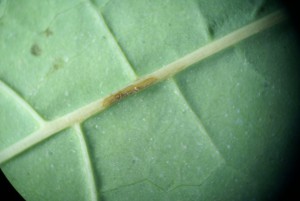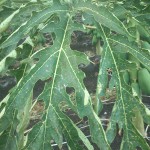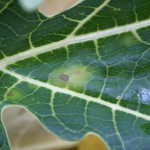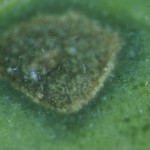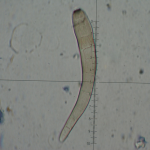Corynespora Cassiicola
Coffee spot of Papaya / Corynespora cassiicola.
The Papaya Coffee stain is caused by the fungus Corynespora cassiicola , this disease is widely distributed in many countries, among which is Mexico. In addition to papaya can be found in many hosts such as cucurbitaceae, Solanaceae among others.
Symptom.
The symptoms caused by this disease can be observed in stems, petioles, fruits and leaves. In the beginning the lesions are small and difficult to observe. On the leaf beam the lesions are pale yellow when it starts and necrotic centers, with yellow halos surrounding the necrosis. On the underside of the leaf it shows slightly sunken brown lesions, hence its name Mancha Café, especially on or near the leaf veins. Conidia can be seen with a magnifying glass (10X) as small hyaline needles, which are large and light brown in color.

Figure 1. Typical lesions of C. cassiicola at the top of the leaf showing the yellow halo on the leaf.
The disease can appear at any stage of the crop when conditions are favorable, with relative humidity above 80%, temperatures between 18 and 30 ° C in addition to periods of wet foliage for more than 24 hours. However, in dry periods, infection on the culture is inhibited. This disease is caused by a microorganism that survives in the soil, with or without the presence of plant residues. The disease can spread rapidly under conditions of humidity and heat, and cause destruction of large amounts of foliage. The optimal conditions for development are temperatures ranging between 20 and 28 ° C, but the infection occurs between 16 and 32 ° C.
- cassiicola control.
- Remove as much as possible the older leaves infected with the fungus in order to favor ventilation and reduce the risk of presence.
- Avoid rotations with susceptible crops such as tomato, cucumber, etc.
Chemical control
Preventive:
- Application of Phosphorous Acid at a dose of 1.0 L / hectare in irrigation from the third month of the plant, applications of Silicon can be made 4 times every 15 days at a dose of 1.0 liters per hectare sprinkling the foliage.
- Apply contact fungicides such as: Copper hydroxide 2g / L water; Copper oxychloride + Mancozeb 2g / L, chlorothalonil 2grs. or mL per liter of water or mancozeb at a dose of 3 gr per liter of water.
Systemic:
Diphenoconazole at a dose of 350 to 500 mL per hectare. Thus, any other authorized triazole fungicide can also be used in admixture or alternation with fungicides that inhibit respiration especially estrobilurines at the recommended doses for each of these.
Note: Applications must be made when the conditions indicated may be favorable for the fungus.
Copyright © All Rights Reserved.
Semillas del Caribe / One Step Ahead
- Figura 4
- Corynespora en hoja
- Corynespora en hoja
- Herida por Corynespora
- Corynespora 4
- Phytophthora 2
